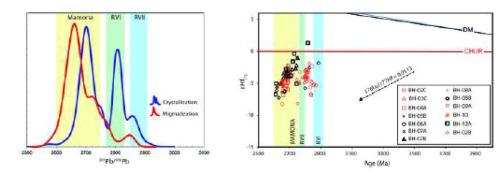Geoscience Frontiers ( IF 8.5 ) Pub Date : 2021-08-21 , DOI: 10.1016/j.gsf.2021.101289 Lorena Martins 1 , Cristiano Lana 1 , Ariela Mazoz 1 , Tiago Novo 2

|
Field observations and CA-LA-ICP-MS U–Pb zircon ages and Hf isotope compositions obtained from migmatitic orthogneisses and granitoids from the Belo Horizonte Complex, southern São Francisco Craton, indicate a major period of partial melting and production of felsic rocks in the Neoarchean. Our observations show that the complex is an important site for studying partial melting processes of Archean crystalline crust. Much of the complex exposes fine-grained stromatic migmatites that are intruded by multiple leucogranitic veins and sheeted dikes. Both migmatites and leucogranite sheets are crosscut by several phases of granitoid batholiths and small granitic bodies; both of which are closely associated with the host banded gneisses. Chemical abrasion followed by detailed cathodoluminescence imaging revealed a wide variety of zircon textures that are consistent with a long-lived period of partial melting and crustal remobilization. Results of U-Pb and Hf isotopes disclose the complex as part of a much wider crustal segment, encompassing the entire southern part of the São Francisco Craton. Compilation of available U-Pb ages suggests that this crustal segment was consolidated sometime between 3000 Ma and 2900 Ma and that it experienced three main episodes of partial melting before stabilization at 2600 Ma. The partial melting episodes took place between 2750 Ma and 2600 Ma as a result of tectonic accretion and peeling off the lithospheric mantle and lower crust. This process is likely responsible for the emplacement of voluminous potassic granitoids across the entire São Francisco Craton. We believe that the partial melting of Meso-Archean crystalline crust and production of potassic granitoids are linked to a fundamental shift in the tectonics of the craton, which was also responsible for the widespread intrusion of large syenitic bodies in the northern part of the craton, and the construction of layered mafic-ultramafic intrusions to the south of the BHC.
中文翻译:

化学磨损 U-Pb 锆石年代学揭示了圣弗朗西斯科克拉通太古代地壳中 150 Myr 的部分熔融事件
野外观测和 CA-LA-ICP-MS U-Pb 锆石年龄和 Hf 同位素组成从混杂质正方麻岩和圣弗朗西斯科克拉通南部贝洛奥里藏特杂岩体中的花岗岩中获得,表明该地区处于一个主要的部分熔融和长英质岩石生产时期。新太古代。我们的观察表明,该复合体是研究太古代结晶地壳部分熔融过程的重要场所。大部分复合体暴露出被多条无色花岗岩脉和片状岩脉侵入的细粒基质混合岩。混合岩和白质花岗岩都被多相花岗岩基岩和小花岗岩体横切;两者都与宿主带状片麻岩密切相关。化学磨损和详细的阴极发光成像揭示了各种各样的锆石质地,这与部分熔融和地壳再活化的长期存在一致。U-Pb 和 Hf 同位素的结果表明,该复合体是更广泛的地壳段的一部分,包括整个圣弗朗西斯科克拉通南部。现有 U-Pb 年龄的汇编表明,该地壳段在 3000 Ma 和 2900 Ma 之间的某个时间被固结,并且在稳定在 2600 Ma 之前经历了三个主要的部分熔融事件。由于构造增生和岩石圈地幔和下地壳的剥落,部分熔融事件发生在 2750-2600Ma。这个过程很可能是导致整个圣弗朗西斯科克拉通大量钾质花岗岩的就位的原因。我们认为,中太古代结晶地壳的部分熔化和钾质花岗岩的产生与克拉通构造的根本转变有关,这也是克拉通北部大型正长岩体广泛侵入的原因,以及在 BHC 南部建造层状镁铁质-超镁铁质侵入体。











































 京公网安备 11010802027423号
京公网安备 11010802027423号